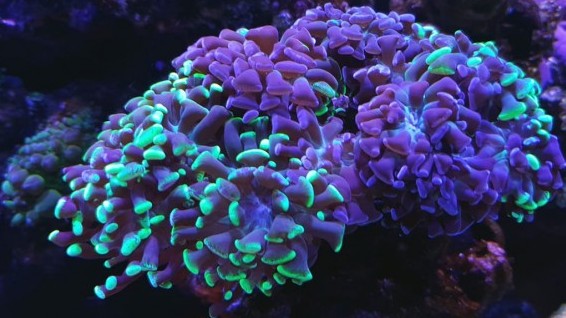Euphyllia Coral Guide - Torches, Hammers and Froggspans
- Jan 23, 2020
- PalaciosAn
- 7594 0 0

[Image provided by Steven Rowland]
Corals of the euphyllia genus are popular in the aquarium hobby. They are classified into three common types torches, hammers, and frogspawn. The three groups have different shapes in their tentacles. The names are given due to their different physical appearance that the posses and not in their genetics. There are also Octospans, which are commonly confused with Frogspawns how they look so similar to one another. There are at least ten separate species of Euphyllia currently in the aquarium trade. Euphyllia corals are famous for a good reason. They can quickly grow to a large colony size from a single frag in the right aquarium conditions with good lighting, water quality, and flow. Their tentacles flow with the water movement and come in several color options, making them perfect for home aquariums.
Euphyllia Coral Placement
One of the most important things to consider is where you place your Euphyllia coral in an aquarium. If you are thinking about where you should put the Euphyllia coral your aquarium, make sure there is an adequate amount of space between the other corals and your euphyllia. This is crucial because euphyllia coral tentacles can reach out and sweeper corals that are placed too close to them. Also, keep in mind the direction of the water flow, the tentacles will flow with the water current that could lead the tentacles toward other corals. The Euphyllia tentacles can contract and expand, especially if they detect nearby corals. Their sting contains toxins that will sting or even kill corals. In smaller tanks, make sure you have ample space as they can grow quickly.

However, if you are planning on having different Euphyllias in your aquarium, similar types can generally be compatible with one another. So for instants, sometimes you can place torches next to other touches, and they will not sting one another. This is not always the case though, even while you have a similar type of Euphyllia next to one another, keep an eye on them and see if you notice the tentacles retracting or if the two Euphyllias tentacles look stuck to one another. These are all signs of aggression to one another, and if you see this, you should separate them immediately to prevent them from stressing one another out.
Water Flow for Euphyllia Corals
Euphyllia corals are very forgiving corals and can adapt to many different types of water flow in an aquarium. If the water flow is too strong, it can damage or kill Euphyllia corals. Strong water flows can peel the flesh off of its skeletal structure. They prefer low-to-moderate flow. The ideal water flow will allow them to extend their sweeper tentacles without any problems and promote growth.
Light Requirments for Euphillia
Light is essential for the growth of most corals. The proper light conditions for any coral are necessary to ensure adequate growth of corals. One of the things that makes Euphyllia popular is the wide range of lighting that they can adapt to in an aquarium. They can be sensitive to significant swings in lighting conditions, so try to place them in a spot with similar light conditions as to where initially. If you are not sure, then you are better off putting it in a lower lighting environment and slowly move it to the spot you want it in gradually.
Handling Euphyllia Corals
You should always handle all corals with care and use proper safety. While there is a lot that we have learned in the hobby, there is still a lot that we do not know. Also, some people can experience allergic reactions to the sting of a coral. In most cases, it's a small irritation to the skin in the area where you were stung but, in some cases, can be more severe. Like most corals, you should try to prevent moving coral to allow them to adapt to their environment. If you see signs of too much flow or if the coral looks like its dying, you should make adjustments to its placement or the water conditions.
Common Euphyllia Disease
Any damage to the Euphyllia tissue could cause a bacterial infection. If there are signs of infection, the fastest course of action is to remove the infected heads. This will help to prevent the infection from spreading throughout the rest of the healthy coral. The most common infection is referred to as "brown jelly disease," how it looks like the coral is covered in brown jelly.
Signs of Stress in Euphyllia Corals
If the tentacles are contracted and are not expand, you need to check the water parameters and flow. Retraction of the tentacles is a sign that the water conditions are less than ideal. When there is an issue with water flow, you could change the direction of the wavemakers, the powerheads, or altogether remove the affected corals.
Feeding Euphyllia Corals
It is not complicated to feeding a Euphyllia corals. All you need to do is squirt food at the species. While there are several items you can buy to feed corals, you can use something as simple as a turkey baster. They are not picky eaters and will feed on brine shrimp, Mysis shrimp, and other small particle foods. Spray the food directly at the euphyllia, or you can even broadcast feed the entire aquarium. The tentacles will take the food and direct it to the mouth of the head. Try to be somewhat conservative when feeding as most people overfeed their aquarium, and the extra food will only contaminate the water. It may take time to figure out the right amount of food to feed them. It is suggested that you fed them once or twice a week







About author
I have been in the hobby for a while, my main focus is automation. I am interested in doing aquaponics in 2018.